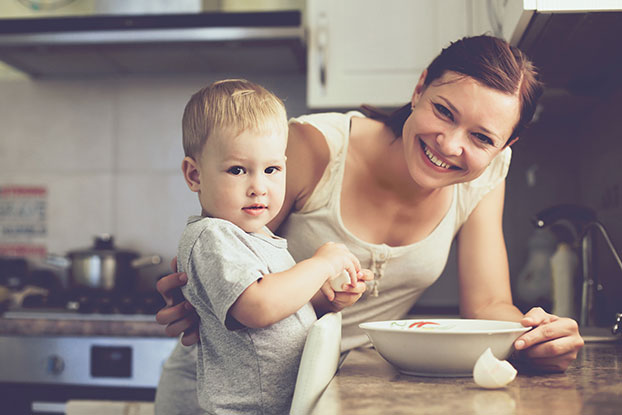35 Tips To Keep Your Children Safe In The Kitchen
October 13th, 2016

The kitchen is the number one spot in the home where children are most at risk of getting injured or sick. Incidents such as kitchen knife accidents, burn injuries, and even contracting food-borne illnesses, can require hospitalisation.
In fact, according to the Children’s Hospital of Wisconsin and Kohl’s Cares, scalds from hot liquids are the number one cause burn injury to children.
While it’s expected that there’ll always be a few minor mishaps when youngsters enter the kitchen, whether they’re making snacks or helping you prepare dinner, you should always supervise them and employ tactics which minimise the risk of serious injury.
As a parent, it’s your responsibility to ensure that the kitchen is a safe environment for your children. To help you on your way, here are some helpful tips.
Tools, utensils and equipment
1. Use the correct kitchen tools for the task at hand.
2. Follow the manufacturer’s guidelines for sharpening and using chopping knives, pressure cookers, food processors, stovetops, and any other appliances.
3. Try a self-locking knife block to store your kitchen knives in safely and prevent your kids from cutting their fingers. Some have a Cam-Lock mechanism where you can only release a knife by firmly pressing a button on the side of the block.
4. Have a working smoke alarm in or near the kitchen.
5. Keep a fire extinguisher in the kitchen.
6. Unless your child’s helping you with the cooking, don’t have a step stool in the kitchen to prevent them from opening high cupboards or locks.
7. Install a baby gate to prevent younger children from entering the kitchen.
Handling and preparing food
8. Use high-quality produce that’s not overripe or damaged, as it’s safer to eat.
9. Wash fruits and vegetables carefully.
10. Wash your hands, kitchen surfaces and utensils thoroughly before and after you handle raw foods.
11. Wear gloves (rubber or latex) when slicing or handling peppers, as pepper oils can burn your skin, and avoid touching your face.
12. Use safety precautions when grilling in order to avoid burns.
13. Don’t change an approved recipe or try an untested recipe.
14. Make sure all jars and lids are properly sterilised.
15. Follow the manufacturer’s safety instructions to ensure jars seal properly and be careful to avoid burns when getting jars out of hot water.
16. Throw out spoiled food to prevent contracting food-borne illnesses.
Cooking
17. Always keep an eye on what you’re cooking on the stove.
18. Make sure pan or pot handles face inwards towards the splashback so your children can’t knock them over.
19. Leave pans or pots on the stove’s back burner when you’re done cooking.
20. Watch out for your kids when carrying pots of hot soup, food or water.
21. Use knob covers and/or stove guards to prevent your child from turning on the stove when you’re not in the kitchen.
22. Establish a 1-metre safety zone; i.e. don’t place items that burn near your stove and burners.
23. Have your children wear tight clothing if they’re helping you cook food on the stove, as loose clothing poses a fire risk. Also avoid clothes made from synthetic fabrics because if they catch on fire they’ll melt, stick to the skin, and cause severe burns.
Cupboards
24. Store toxic household cleaners (such as detergent, bleach, and pesticides) and medication in a high cupboard where your child can’t reach, and keep them under lock and key.
25. Store glassware, graters, utensils and sharp tools in higher cupboards. If this isn’t possible, then latch the drawers securely and don’t leave anything dangerous on the counter.
26. Organise a ‘safe’ cupboard that has things your children can play with, such as wooden spoons and plastic containers. It should be located far away from the stove and oven, and within your supervision radius.
Trash can
27. Get a trash can with a lockable lid or latch the one you have securely so your kids can’t access opened cans with sharp edges, fruit peels, or glass shards if you break something.
28. You can also get another trash can for your child to play with, and fill it will harmless items such as paper and old egg cartons.
Microwave and oven
29. Install a child-lock so that your child can’t open the microwave or oven.
30. Use potholders when removing hot food from the microwave or oven.
31. Unplug the microwave when not in use.
32. Store the microwave in a high place your child can’t reach.
Fridge
33. Install a child-lock on your fridge so your child can’t access what’s inside.
34. Don’t place magnets on the fridge that your kids can break off and swallow. Keep magnets at a height where your children can’t reach them.
35. Disable or lock your water dispenser, as water puddles on the floor or ice can pose a serious hazard.
Keeping your children safe in the kitchen
Don’t assume that your kids know what’s safe and unsafe to do in the kitchen. Make sure you establish clear guidelines and teach them best safety practices. By putting safety first and talking to your children about kitchen hazards and ways to stay safe, you’ll help ensure they don’t ever come to serious harm.
